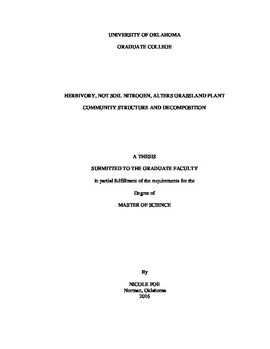| dc.contributor.advisor | Souza, Lara | |
| dc.contributor.author | Poe, Nicole | |
| dc.date.accessioned | 2016-12-08T16:51:35Z | |
| dc.date.available | 2016-12-08T16:51:35Z | |
| dc.date.issued | 2016-12 | |
| dc.identifier.uri | https://hdl.handle.net/11244/47018 | |
| dc.description.abstract | Human activity has shifted grazing and nitrogen (N) altering plant community structure worldwide. Plant community changes are expected to alter associated ecosystem functions (e.g., plant litter decomposition). Few studies address the concurrent effects of grazing and nitrogen inputs on community structure and ecosystem function. To better understand how herbivory and soil N availability can alter grassland structure and function, we first manipulated soil N (soil N addition vs. control) and invertebrate herbivory (present vs. reduced) within an established small mammal herbivore manipulation (small mammal present vs. reduced). We measured plant community structure (richness, evenness, diversity and composition) and productivity. Secondly, we collected plant litter and soil samples from grazing and soil N manipulated plots. We created microcosms similar to field plots by creating soil and litter laboratory incubations. From the microcosms, we measured soil CO2 evolution as a proxy for plant litter decomposition. We found that small mammal and invertebrate herbivores, rather than soil nitrogen, altered grassland community structure and function. The presence of small mammal herbivores promoted plant species richness and diversity while decreasing productivity and altering compositional similarity. Invertebrate herbivores promoted plant dominance by reducing plant evenness without altering compositional similarity. Additionally, small mammals mediated the impacts of invertebrate herbivores such that invertebrates lowered plant diversity when small mammals were abundant, while promoting plant diversity when small mammals were reduced. Also, small mammal herbivory shifted species composition by promoting C3 relative to C4 plant species abundance. Further, shifts in plant community composition led to greater plant litter decomposition rates. Microcosms representative of small mammal access plots had a 15% higher decomposition rate than small mammal reduction microcosms. Our findings provide further evidence that temperate grasslands can be strongly influenced by consumers rather than resources. | en_US |
| dc.language | en_US | en_US |
| dc.subject | small mammal herbivores, plant species composition, litter quality, laboratory incubation | en_US |
| dc.title | Herbivory, not soil nitrogen, alters grassland plant community structure and decomposition | en_US |
| dc.contributor.committeeMember | Luo, Yiqi | |
| dc.contributor.committeeMember | Stevenson, Bradley | |
| dc.date.manuscript | 2016-12 | |
| dc.thesis.degree | Master of Science | en_US |
| ou.group | College of Arts and Sciences::Department of Microbiology and Plant Biology | en_US |
| shareok.orcid | 0000-0002-0808-9340 | en_US |
| shareok.nativefileaccess | restricted | en_US |
